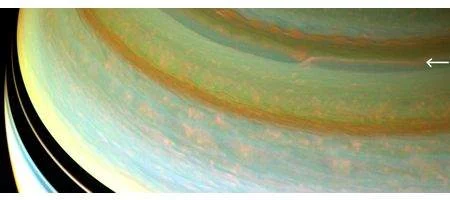Scientists believe they’ve discovered the origins of Saturn’s turbulent jet streams, which whip across the planet east and west.

Using images collected over several years by NASA’s Cassini spacecraft, they’ve discovered that the heat from within the planet gives the jet streams their power.
Condensation of water from Saturn’s internal heating leads to temperature differences in the atmosphere that create eddies; and those eddies, in turn, accelerate the jet streams like rotating gears driving a conveyor belt.
The discovery eliminates the competing theory that the energy for the temperature differences came from the sun – which is the mechanism for smilar jet streams on Earth.
“We know the atmospheres of planets such as Saturn and Jupiter can get their energy from only two places: the sun or the internal heating. The challenge has been coming up with ways to use the data so that we can tell the difference,” says Tony Del Genio of NASA’s Goddard Institute for Space Studies.
As a gas giant, Saturn’s deep atmosphere is layered with multiple cloud decks at high altitudes. A series of jet streams slice across the planet where the temperature varies significantly from one latitude to another, and, while most blow eastward, some blow west.
In the new study, which is a follow-up to results published in 2007, the team used automated cloud tracking software to analyze the movements and speeds of clouds seen in hundreds of Cassini images from 2005 through 2012.
“With our improved tracking algorithm, we’ve been able to extract nearly 120,000 wind vectors from 560 images, giving us an unprecedented picture of Saturn’s wind flow at two independent altitudes on a global scale,” says John Barbara of the Goddard Institute for Space Studies.
By seeing for the first time how eddies accelerate the jet streams at two different altitudes, scientists found the eddies were weaker at the higher altitudes where previous researchers had found that most of the sun’s heating occurs. They were stronger deeper in the atmosphere.
This implies that, rather than the sun, it’s the internal heat of the planet that’s ultimately driving the acceleration of the jet streams, probably by stirring up water vapor from Saturn’s interior.






